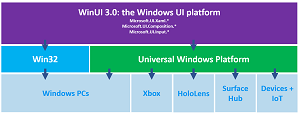News
Microsoft Advances Native UI Platform for Windows, WinUI
Microsoft this week launched a new web site for WinUI, its native UI platform for applications running on Windows 10 devices, as a new version 3 is offered in beta.
WinUI is used to build rich .NET and C++ applications and also to power Microsoft properties including the Windows and Xbox OS shells, along with platforms such as Xamarin.Forms and React Native Windows. It was open sourced by Microsoft in 2018. The stable WinUI 2.x series works only with Universal Windows Platform (UWP) applications, providing them with some of the latest XAML controls and Fluent Design functionality.
The new WinUI site mainly extols the virtues of the platform, while also providing a link to try out the WinUI 3.0 alpha offering that improves on the previous UWP-only WinUI 2.x series, which itself is still receiving updates.
WinUI 3.0 will be the full UI stack, including XAML, composition and input, not tied to UWP.
 [Click on image for larger view.] WinUI 3 (source: Microsoft).
[Click on image for larger view.] WinUI 3 (source: Microsoft).
"So we have a bunch of goals with this" said a dev team member during last month's regular WinUI Community Call (a March call was in progress during the writing of this article and will probably be posted soon).
With a scheduled delivery time-frame of "2020," the goals sought in WinUI 3.0 include:
- full UI stack now decoupled from the OS
- removing barriers between UWP and Win32 (desktop): works with both
- support .NET 5 and C++
- backward-compatible on Windows 10
.NET 5, of course, is the unifying project to bundle all things .NET into one platform. Its first preview just shipped ahead of a November GA release date.
While the UWP decoupling is the main new feature being implemented in WinUI 3.0, some other new features planned include:
- Downlevel support (backward compatibility) for all existing features: new Xaml and Composition features that were added in the Windows May 2019 Update will now work on Creators Update and newer!
- A new Microsoft Edge (Chromium) WebView Xaml control
- Input validation support
- New Visual Studio 2019 app templates for different combinations of app type (Win32, UWP) and language (.NET, C++)
More resources available to explore WinUI include:
About the Author
David Ramel is an editor and writer at Converge 360.